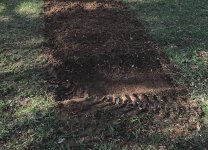rossn
Silver Member
I received my compact tiller last week, and am ready to get going with the garden prep -- however, need some advice on tilling and amending the first time! My soil is 60% Sand, 20% Clay, 20% Silt. It's rock hard when it's dry. Surprisingly, I haven't found many rocks in this soil, since I moved in a year ago.
The primary area I'll be working with my Massey Ferguson SCUT is 80x30. Last summer I worked a patch of it - about 1/4 of it by using a single bottom plow (for the first time) and hand tilling it. The ground was rock hard at the time, and it required a lot of work. Ultimately, I'm looking to break up the entire area and till in about 1.5-2" of compost.
Over the past two weeks, we've received several inches of water, either though rain or snow. It last rained maybe 4 days ago. No rain on the forecast before next weekend. The ground is no longer frozen, and our typical last frost date is May 10, though I'd like to get some cool weather stuff going soon. The attachments I have are a single bottom plow, a 48" tiller, and next week I should receive a subsoiler/potato plow.
My questions are:
- what to do when (given current state of moisture)
- how many passes to make
- how to be sure I'm not over-working the soil
- when to apply the compost (and any natural fertilizer) in the process
- if I need to have some period of time between passes and planting (possibly with a final pass) to kill any weeds/grass
That's a lot, so thanks in advance!!
The primary area I'll be working with my Massey Ferguson SCUT is 80x30. Last summer I worked a patch of it - about 1/4 of it by using a single bottom plow (for the first time) and hand tilling it. The ground was rock hard at the time, and it required a lot of work. Ultimately, I'm looking to break up the entire area and till in about 1.5-2" of compost.
Over the past two weeks, we've received several inches of water, either though rain or snow. It last rained maybe 4 days ago. No rain on the forecast before next weekend. The ground is no longer frozen, and our typical last frost date is May 10, though I'd like to get some cool weather stuff going soon. The attachments I have are a single bottom plow, a 48" tiller, and next week I should receive a subsoiler/potato plow.
My questions are:
- what to do when (given current state of moisture)
- how many passes to make
- how to be sure I'm not over-working the soil
- when to apply the compost (and any natural fertilizer) in the process
- if I need to have some period of time between passes and planting (possibly with a final pass) to kill any weeds/grass
That's a lot, so thanks in advance!!
